A Comprehensive Report on PERT and CPM in Project Management
VerifiedAdded on 2020/04/29
|16
|4190
|572
Report
AI Summary
This report provides a detailed overview of PERT (Program Evaluation and Review Technique) and CPM (Critical Path Method), two essential tools in project management. It begins with an introduction to the challenges of managing large-scale projects and the importance of effective planning and coordination. The report then describes PERT and CPM, discussing their historical development, basic steps in networking techniques, and methodologies. It explores the application of these techniques across various sectors, including construction, research and development, and IT projects. A comparison between PERT and CPM is presented, followed by an analysis of their limitations. The report includes figures illustrating project crashing, time and cost relationships, and network diagrams to enhance understanding. The report emphasizes the significance of these tools in planning, scheduling, resource allocation, and controlling projects, making it a valuable resource for understanding and implementing effective project management strategies.

PROJECT
MANAGEMENT
MANAGEMENT
Paraphrase This Document
Need a fresh take? Get an instant paraphrase of this document with our AI Paraphraser
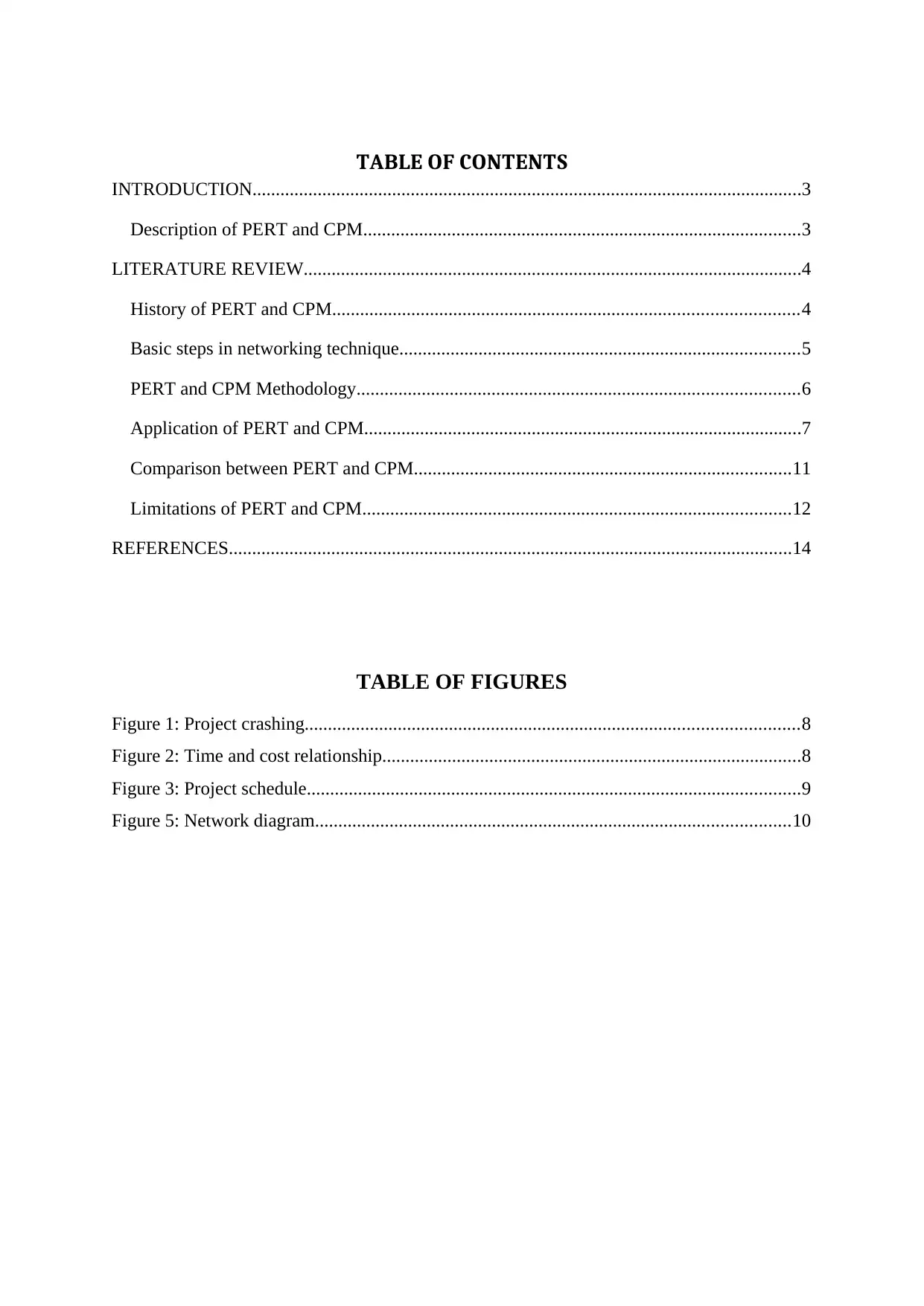
TABLE OF CONTENTS
INTRODUCTION......................................................................................................................3
Description of PERT and CPM..............................................................................................3
LITERATURE REVIEW...........................................................................................................4
History of PERT and CPM....................................................................................................4
Basic steps in networking technique......................................................................................5
PERT and CPM Methodology...............................................................................................6
Application of PERT and CPM..............................................................................................7
Comparison between PERT and CPM.................................................................................11
Limitations of PERT and CPM............................................................................................12
REFERENCES.........................................................................................................................14
TABLE OF FIGURES
Figure 1: Project crashing..........................................................................................................8
Figure 2: Time and cost relationship..........................................................................................8
Figure 3: Project schedule..........................................................................................................9
Figure 5: Network diagram......................................................................................................10
INTRODUCTION......................................................................................................................3
Description of PERT and CPM..............................................................................................3
LITERATURE REVIEW...........................................................................................................4
History of PERT and CPM....................................................................................................4
Basic steps in networking technique......................................................................................5
PERT and CPM Methodology...............................................................................................6
Application of PERT and CPM..............................................................................................7
Comparison between PERT and CPM.................................................................................11
Limitations of PERT and CPM............................................................................................12
REFERENCES.........................................................................................................................14
TABLE OF FIGURES
Figure 1: Project crashing..........................................................................................................8
Figure 2: Time and cost relationship..........................................................................................8
Figure 3: Project schedule..........................................................................................................9
Figure 5: Network diagram......................................................................................................10

INTRODUCTION
The business organisations face most of the challenges in their jobs while managing a
large scale projects as these projects are completed through executing a number of activities
which are complex to manage (Fleming and Koppelman, 2016). For this purpose, it is
essential to plan and coordinate in a highly effective manner so that a realistic schedule can
be developed. As per this, further process regarding monitoring of project is also made. In
this entire project, management is done with the help of PERT (Programme Evaluation and
Review Technique) and CPM (Critical Path Method) (Garel, 2013). These techniques assist
in carrying out different responsibilities that are expected to be done by the project manager.
These techniques basically make use of networks which helps in planning and coordination
of all the activities. For this purpose, a software package is used for managing data and
developing the scheduled information. The current report is based on discussion related to
PERT and CPM which are the major requirements in project management.
Description of PERT and CPM
PERT and CPM are the most effective tools that are extensively used in the
management of large scale projects. The major use of these projects are done in constructions
sector, research and development of a new product, movie productions, installing a new MIS
or in conducting a new advertisement campaign. The PERT and CPM were developed on
independent basis in the late 1950s. Today’s software packages extensively use options for
both of the tools (Acebes, Pajares, Galán and López-Paredes, 2014). These two techniques
have been merged over the years for assisting in managing various large level projects. PERT
was initially developed in 1950s by the Navy specialist officers with the management team.
Since then, this tool is widely used by different branches of government industries to develop
products and executing researches. In present time, PERT is widely used by different
contractors on large scale for managing and scheduling of their projects in easier way.
Similarly, the CPM was firstly developed in 1957 by J.E. Kelly and M.R. Walker. The
CPM technique differs from PERT in the minor details related to management if time and
cost treatment under this (Lee, et,al., 2016). While, it is evident that extensive features used
by the business firms related to both the techniques have made some distinctions vague. The
industries have made an integration of the features that are highly used in management of
porojects so that its utility and ease if use can be enhanced. Both the techniques present a
The business organisations face most of the challenges in their jobs while managing a
large scale projects as these projects are completed through executing a number of activities
which are complex to manage (Fleming and Koppelman, 2016). For this purpose, it is
essential to plan and coordinate in a highly effective manner so that a realistic schedule can
be developed. As per this, further process regarding monitoring of project is also made. In
this entire project, management is done with the help of PERT (Programme Evaluation and
Review Technique) and CPM (Critical Path Method) (Garel, 2013). These techniques assist
in carrying out different responsibilities that are expected to be done by the project manager.
These techniques basically make use of networks which helps in planning and coordination
of all the activities. For this purpose, a software package is used for managing data and
developing the scheduled information. The current report is based on discussion related to
PERT and CPM which are the major requirements in project management.
Description of PERT and CPM
PERT and CPM are the most effective tools that are extensively used in the
management of large scale projects. The major use of these projects are done in constructions
sector, research and development of a new product, movie productions, installing a new MIS
or in conducting a new advertisement campaign. The PERT and CPM were developed on
independent basis in the late 1950s. Today’s software packages extensively use options for
both of the tools (Acebes, Pajares, Galán and López-Paredes, 2014). These two techniques
have been merged over the years for assisting in managing various large level projects. PERT
was initially developed in 1950s by the Navy specialist officers with the management team.
Since then, this tool is widely used by different branches of government industries to develop
products and executing researches. In present time, PERT is widely used by different
contractors on large scale for managing and scheduling of their projects in easier way.
Similarly, the CPM was firstly developed in 1957 by J.E. Kelly and M.R. Walker. The
CPM technique differs from PERT in the minor details related to management if time and
cost treatment under this (Lee, et,al., 2016). While, it is evident that extensive features used
by the business firms related to both the techniques have made some distinctions vague. The
industries have made an integration of the features that are highly used in management of
porojects so that its utility and ease if use can be enhanced. Both the techniques present a
⊘ This is a preview!⊘
Do you want full access?
Subscribe today to unlock all pages.

Trusted by 1+ million students worldwide
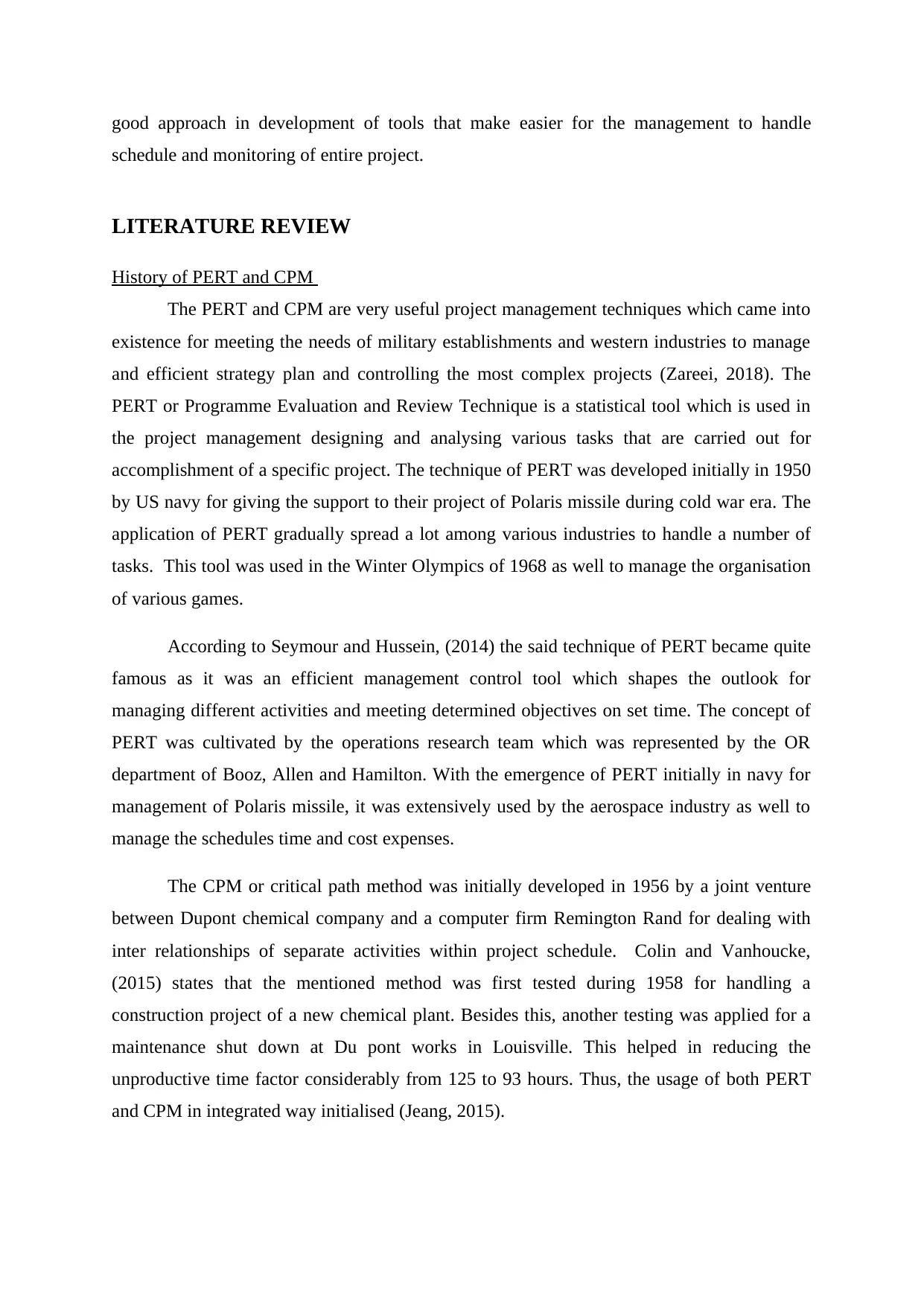
good approach in development of tools that make easier for the management to handle
schedule and monitoring of entire project.
LITERATURE REVIEW
History of PERT and CPM
The PERT and CPM are very useful project management techniques which came into
existence for meeting the needs of military establishments and western industries to manage
and efficient strategy plan and controlling the most complex projects (Zareei, 2018). The
PERT or Programme Evaluation and Review Technique is a statistical tool which is used in
the project management designing and analysing various tasks that are carried out for
accomplishment of a specific project. The technique of PERT was developed initially in 1950
by US navy for giving the support to their project of Polaris missile during cold war era. The
application of PERT gradually spread a lot among various industries to handle a number of
tasks. This tool was used in the Winter Olympics of 1968 as well to manage the organisation
of various games.
According to Seymour and Hussein, (2014) the said technique of PERT became quite
famous as it was an efficient management control tool which shapes the outlook for
managing different activities and meeting determined objectives on set time. The concept of
PERT was cultivated by the operations research team which was represented by the OR
department of Booz, Allen and Hamilton. With the emergence of PERT initially in navy for
management of Polaris missile, it was extensively used by the aerospace industry as well to
manage the schedules time and cost expenses.
The CPM or critical path method was initially developed in 1956 by a joint venture
between Dupont chemical company and a computer firm Remington Rand for dealing with
inter relationships of separate activities within project schedule. Colin and Vanhoucke,
(2015) states that the mentioned method was first tested during 1958 for handling a
construction project of a new chemical plant. Besides this, another testing was applied for a
maintenance shut down at Du pont works in Louisville. This helped in reducing the
unproductive time factor considerably from 125 to 93 hours. Thus, the usage of both PERT
and CPM in integrated way initialised (Jeang, 2015).
schedule and monitoring of entire project.
LITERATURE REVIEW
History of PERT and CPM
The PERT and CPM are very useful project management techniques which came into
existence for meeting the needs of military establishments and western industries to manage
and efficient strategy plan and controlling the most complex projects (Zareei, 2018). The
PERT or Programme Evaluation and Review Technique is a statistical tool which is used in
the project management designing and analysing various tasks that are carried out for
accomplishment of a specific project. The technique of PERT was developed initially in 1950
by US navy for giving the support to their project of Polaris missile during cold war era. The
application of PERT gradually spread a lot among various industries to handle a number of
tasks. This tool was used in the Winter Olympics of 1968 as well to manage the organisation
of various games.
According to Seymour and Hussein, (2014) the said technique of PERT became quite
famous as it was an efficient management control tool which shapes the outlook for
managing different activities and meeting determined objectives on set time. The concept of
PERT was cultivated by the operations research team which was represented by the OR
department of Booz, Allen and Hamilton. With the emergence of PERT initially in navy for
management of Polaris missile, it was extensively used by the aerospace industry as well to
manage the schedules time and cost expenses.
The CPM or critical path method was initially developed in 1956 by a joint venture
between Dupont chemical company and a computer firm Remington Rand for dealing with
inter relationships of separate activities within project schedule. Colin and Vanhoucke,
(2015) states that the mentioned method was first tested during 1958 for handling a
construction project of a new chemical plant. Besides this, another testing was applied for a
maintenance shut down at Du pont works in Louisville. This helped in reducing the
unproductive time factor considerably from 125 to 93 hours. Thus, the usage of both PERT
and CPM in integrated way initialised (Jeang, 2015).
Paraphrase This Document
Need a fresh take? Get an instant paraphrase of this document with our AI Paraphraser
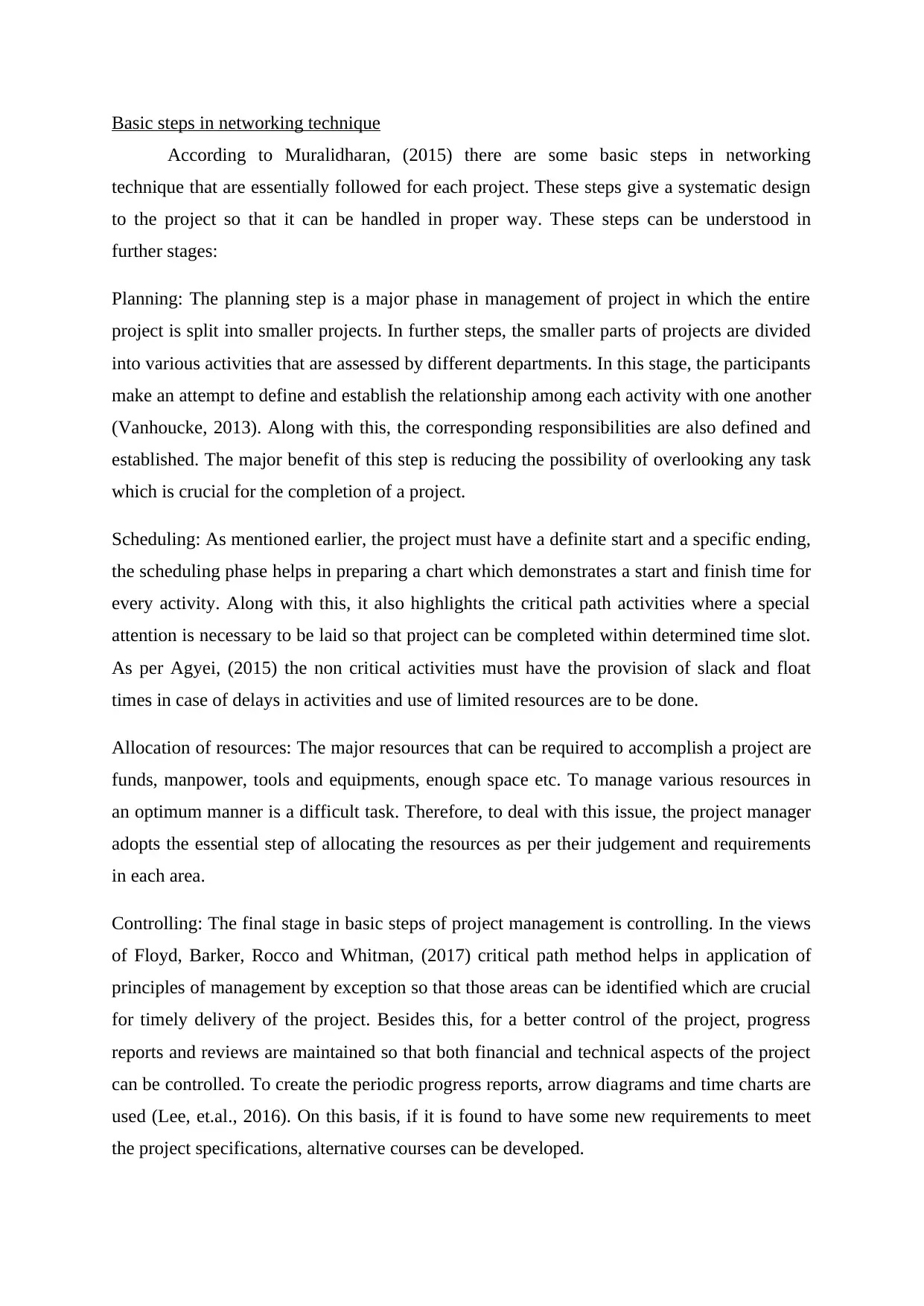
Basic steps in networking technique
According to Muralidharan, (2015) there are some basic steps in networking
technique that are essentially followed for each project. These steps give a systematic design
to the project so that it can be handled in proper way. These steps can be understood in
further stages:
Planning: The planning step is a major phase in management of project in which the entire
project is split into smaller projects. In further steps, the smaller parts of projects are divided
into various activities that are assessed by different departments. In this stage, the participants
make an attempt to define and establish the relationship among each activity with one another
(Vanhoucke, 2013). Along with this, the corresponding responsibilities are also defined and
established. The major benefit of this step is reducing the possibility of overlooking any task
which is crucial for the completion of a project.
Scheduling: As mentioned earlier, the project must have a definite start and a specific ending,
the scheduling phase helps in preparing a chart which demonstrates a start and finish time for
every activity. Along with this, it also highlights the critical path activities where a special
attention is necessary to be laid so that project can be completed within determined time slot.
As per Agyei, (2015) the non critical activities must have the provision of slack and float
times in case of delays in activities and use of limited resources are to be done.
Allocation of resources: The major resources that can be required to accomplish a project are
funds, manpower, tools and equipments, enough space etc. To manage various resources in
an optimum manner is a difficult task. Therefore, to deal with this issue, the project manager
adopts the essential step of allocating the resources as per their judgement and requirements
in each area.
Controlling: The final stage in basic steps of project management is controlling. In the views
of Floyd, Barker, Rocco and Whitman, (2017) critical path method helps in application of
principles of management by exception so that those areas can be identified which are crucial
for timely delivery of the project. Besides this, for a better control of the project, progress
reports and reviews are maintained so that both financial and technical aspects of the project
can be controlled. To create the periodic progress reports, arrow diagrams and time charts are
used (Lee, et.al., 2016). On this basis, if it is found to have some new requirements to meet
the project specifications, alternative courses can be developed.
According to Muralidharan, (2015) there are some basic steps in networking
technique that are essentially followed for each project. These steps give a systematic design
to the project so that it can be handled in proper way. These steps can be understood in
further stages:
Planning: The planning step is a major phase in management of project in which the entire
project is split into smaller projects. In further steps, the smaller parts of projects are divided
into various activities that are assessed by different departments. In this stage, the participants
make an attempt to define and establish the relationship among each activity with one another
(Vanhoucke, 2013). Along with this, the corresponding responsibilities are also defined and
established. The major benefit of this step is reducing the possibility of overlooking any task
which is crucial for the completion of a project.
Scheduling: As mentioned earlier, the project must have a definite start and a specific ending,
the scheduling phase helps in preparing a chart which demonstrates a start and finish time for
every activity. Along with this, it also highlights the critical path activities where a special
attention is necessary to be laid so that project can be completed within determined time slot.
As per Agyei, (2015) the non critical activities must have the provision of slack and float
times in case of delays in activities and use of limited resources are to be done.
Allocation of resources: The major resources that can be required to accomplish a project are
funds, manpower, tools and equipments, enough space etc. To manage various resources in
an optimum manner is a difficult task. Therefore, to deal with this issue, the project manager
adopts the essential step of allocating the resources as per their judgement and requirements
in each area.
Controlling: The final stage in basic steps of project management is controlling. In the views
of Floyd, Barker, Rocco and Whitman, (2017) critical path method helps in application of
principles of management by exception so that those areas can be identified which are crucial
for timely delivery of the project. Besides this, for a better control of the project, progress
reports and reviews are maintained so that both financial and technical aspects of the project
can be controlled. To create the periodic progress reports, arrow diagrams and time charts are
used (Lee, et.al., 2016). On this basis, if it is found to have some new requirements to meet
the project specifications, alternative courses can be developed.
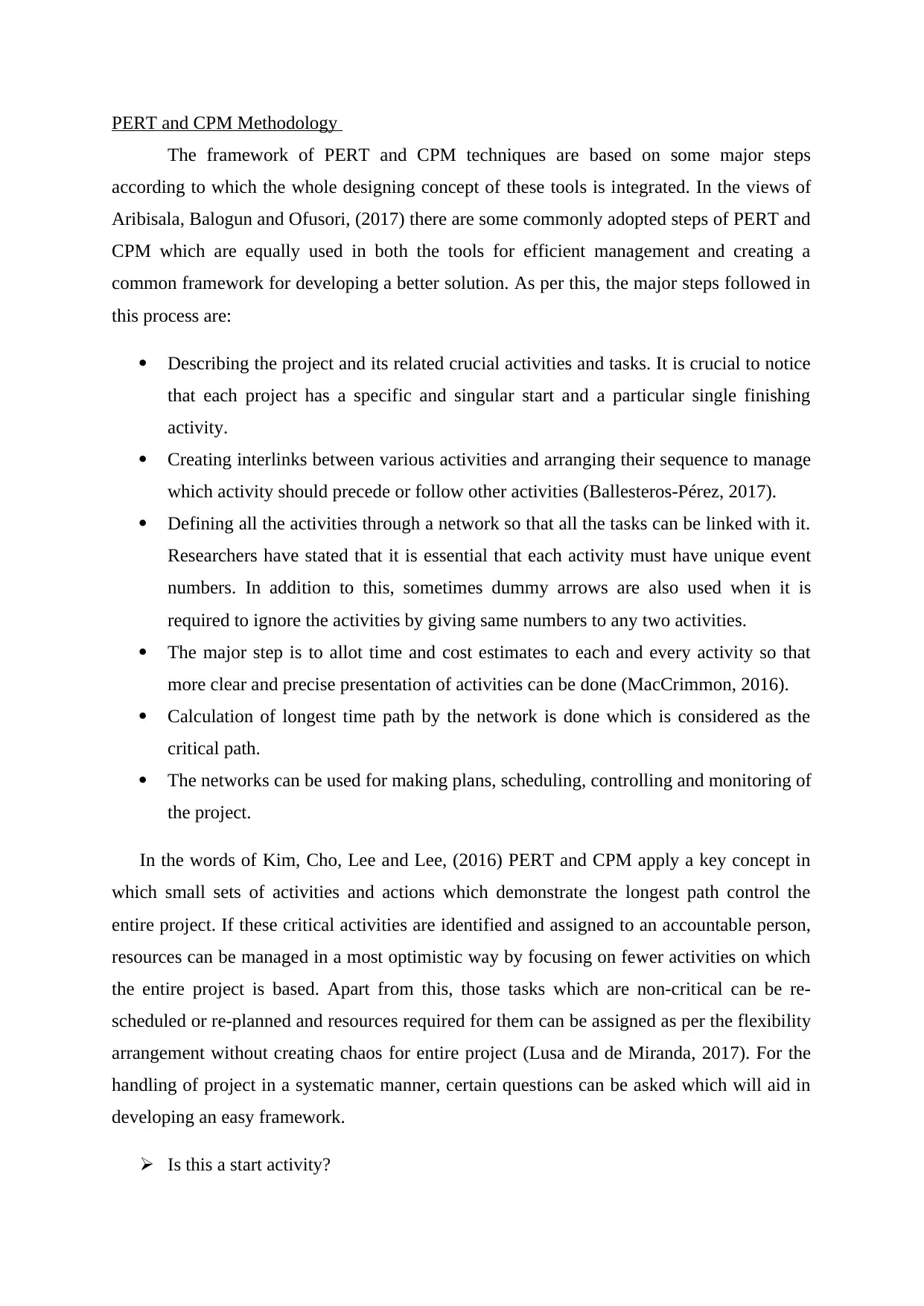
PERT and CPM Methodology
The framework of PERT and CPM techniques are based on some major steps
according to which the whole designing concept of these tools is integrated. In the views of
Aribisala, Balogun and Ofusori, (2017) there are some commonly adopted steps of PERT and
CPM which are equally used in both the tools for efficient management and creating a
common framework for developing a better solution. As per this, the major steps followed in
this process are:
Describing the project and its related crucial activities and tasks. It is crucial to notice
that each project has a specific and singular start and a particular single finishing
activity.
Creating interlinks between various activities and arranging their sequence to manage
which activity should precede or follow other activities (Ballesteros-Pérez, 2017).
Defining all the activities through a network so that all the tasks can be linked with it.
Researchers have stated that it is essential that each activity must have unique event
numbers. In addition to this, sometimes dummy arrows are also used when it is
required to ignore the activities by giving same numbers to any two activities.
The major step is to allot time and cost estimates to each and every activity so that
more clear and precise presentation of activities can be done (MacCrimmon, 2016).
Calculation of longest time path by the network is done which is considered as the
critical path.
The networks can be used for making plans, scheduling, controlling and monitoring of
the project.
In the words of Kim, Cho, Lee and Lee, (2016) PERT and CPM apply a key concept in
which small sets of activities and actions which demonstrate the longest path control the
entire project. If these critical activities are identified and assigned to an accountable person,
resources can be managed in a most optimistic way by focusing on fewer activities on which
the entire project is based. Apart from this, those tasks which are non-critical can be re-
scheduled or re-planned and resources required for them can be assigned as per the flexibility
arrangement without creating chaos for entire project (Lusa and de Miranda, 2017). For the
handling of project in a systematic manner, certain questions can be asked which will aid in
developing an easy framework.
Is this a start activity?
The framework of PERT and CPM techniques are based on some major steps
according to which the whole designing concept of these tools is integrated. In the views of
Aribisala, Balogun and Ofusori, (2017) there are some commonly adopted steps of PERT and
CPM which are equally used in both the tools for efficient management and creating a
common framework for developing a better solution. As per this, the major steps followed in
this process are:
Describing the project and its related crucial activities and tasks. It is crucial to notice
that each project has a specific and singular start and a particular single finishing
activity.
Creating interlinks between various activities and arranging their sequence to manage
which activity should precede or follow other activities (Ballesteros-Pérez, 2017).
Defining all the activities through a network so that all the tasks can be linked with it.
Researchers have stated that it is essential that each activity must have unique event
numbers. In addition to this, sometimes dummy arrows are also used when it is
required to ignore the activities by giving same numbers to any two activities.
The major step is to allot time and cost estimates to each and every activity so that
more clear and precise presentation of activities can be done (MacCrimmon, 2016).
Calculation of longest time path by the network is done which is considered as the
critical path.
The networks can be used for making plans, scheduling, controlling and monitoring of
the project.
In the words of Kim, Cho, Lee and Lee, (2016) PERT and CPM apply a key concept in
which small sets of activities and actions which demonstrate the longest path control the
entire project. If these critical activities are identified and assigned to an accountable person,
resources can be managed in a most optimistic way by focusing on fewer activities on which
the entire project is based. Apart from this, those tasks which are non-critical can be re-
scheduled or re-planned and resources required for them can be assigned as per the flexibility
arrangement without creating chaos for entire project (Lusa and de Miranda, 2017). For the
handling of project in a systematic manner, certain questions can be asked which will aid in
developing an easy framework.
Is this a start activity?
⊘ This is a preview!⊘
Do you want full access?
Subscribe today to unlock all pages.

Trusted by 1+ million students worldwide
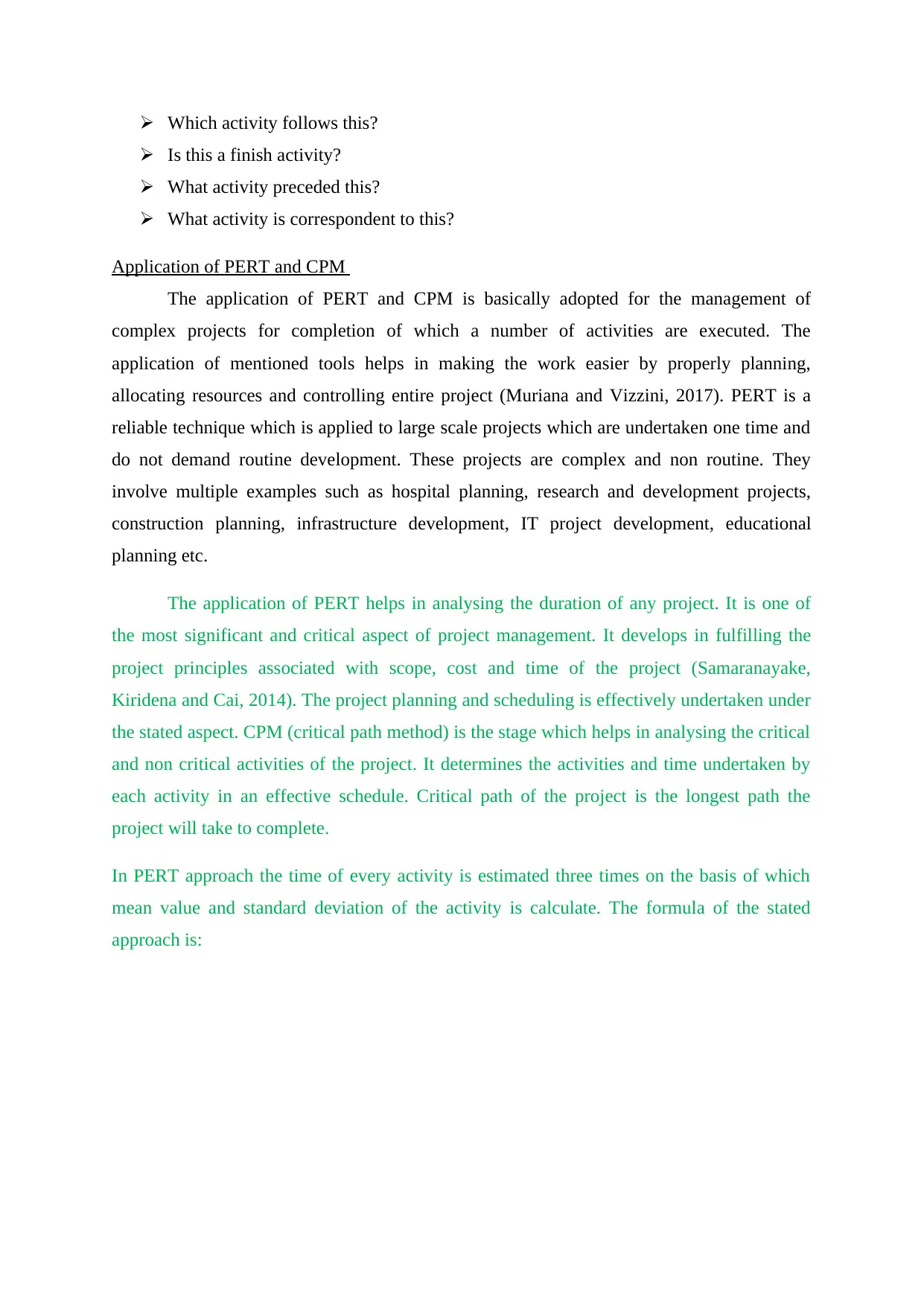
Which activity follows this?
Is this a finish activity?
What activity preceded this?
What activity is correspondent to this?
Application of PERT and CPM
The application of PERT and CPM is basically adopted for the management of
complex projects for completion of which a number of activities are executed. The
application of mentioned tools helps in making the work easier by properly planning,
allocating resources and controlling entire project (Muriana and Vizzini, 2017). PERT is a
reliable technique which is applied to large scale projects which are undertaken one time and
do not demand routine development. These projects are complex and non routine. They
involve multiple examples such as hospital planning, research and development projects,
construction planning, infrastructure development, IT project development, educational
planning etc.
The application of PERT helps in analysing the duration of any project. It is one of
the most significant and critical aspect of project management. It develops in fulfilling the
project principles associated with scope, cost and time of the project (Samaranayake,
Kiridena and Cai, 2014). The project planning and scheduling is effectively undertaken under
the stated aspect. CPM (critical path method) is the stage which helps in analysing the critical
and non critical activities of the project. It determines the activities and time undertaken by
each activity in an effective schedule. Critical path of the project is the longest path the
project will take to complete.
In PERT approach the time of every activity is estimated three times on the basis of which
mean value and standard deviation of the activity is calculate. The formula of the stated
approach is:
Is this a finish activity?
What activity preceded this?
What activity is correspondent to this?
Application of PERT and CPM
The application of PERT and CPM is basically adopted for the management of
complex projects for completion of which a number of activities are executed. The
application of mentioned tools helps in making the work easier by properly planning,
allocating resources and controlling entire project (Muriana and Vizzini, 2017). PERT is a
reliable technique which is applied to large scale projects which are undertaken one time and
do not demand routine development. These projects are complex and non routine. They
involve multiple examples such as hospital planning, research and development projects,
construction planning, infrastructure development, IT project development, educational
planning etc.
The application of PERT helps in analysing the duration of any project. It is one of
the most significant and critical aspect of project management. It develops in fulfilling the
project principles associated with scope, cost and time of the project (Samaranayake,
Kiridena and Cai, 2014). The project planning and scheduling is effectively undertaken under
the stated aspect. CPM (critical path method) is the stage which helps in analysing the critical
and non critical activities of the project. It determines the activities and time undertaken by
each activity in an effective schedule. Critical path of the project is the longest path the
project will take to complete.
In PERT approach the time of every activity is estimated three times on the basis of which
mean value and standard deviation of the activity is calculate. The formula of the stated
approach is:
Paraphrase This Document
Need a fresh take? Get an instant paraphrase of this document with our AI Paraphraser
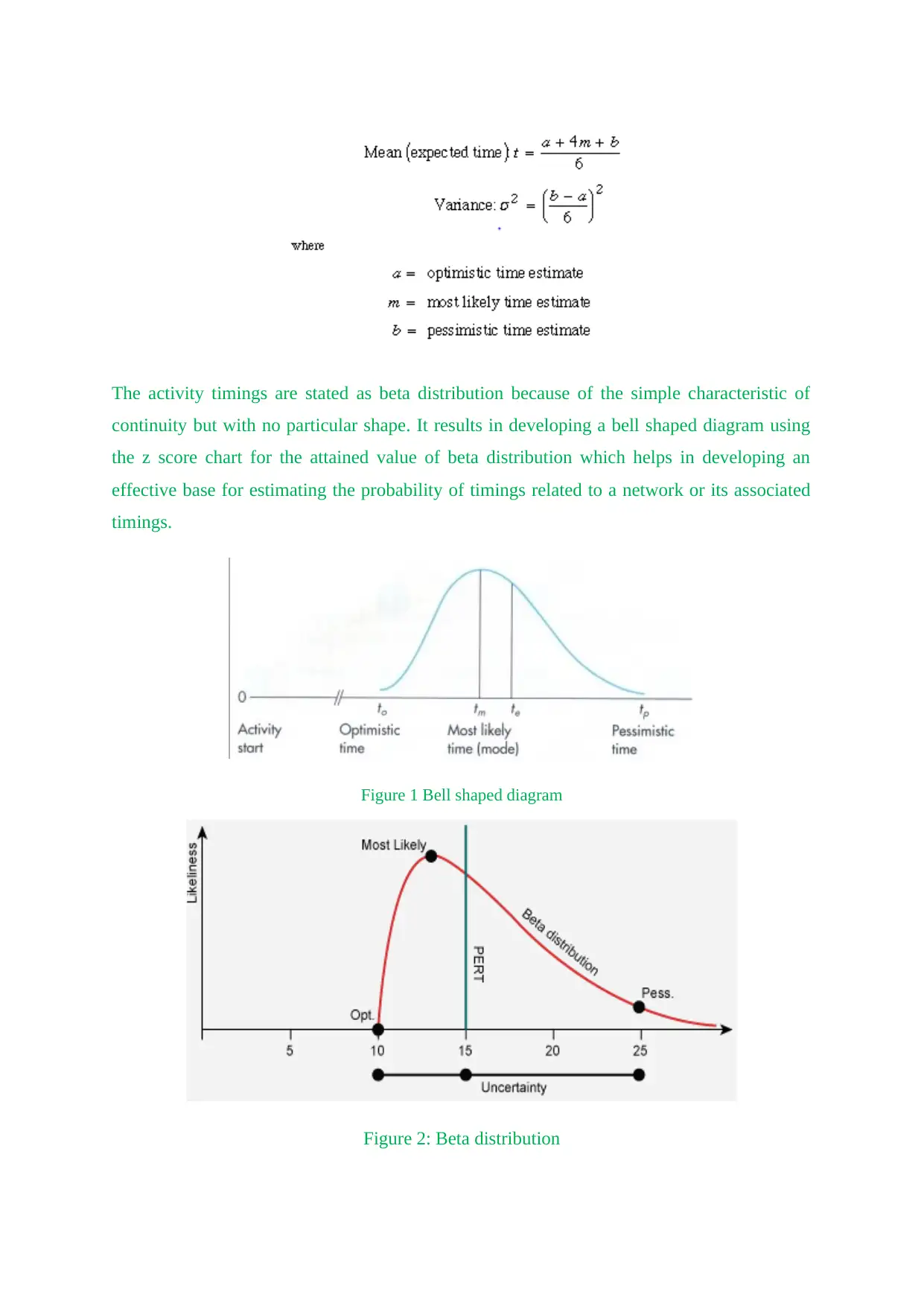
The activity timings are stated as beta distribution because of the simple characteristic of
continuity but with no particular shape. It results in developing a bell shaped diagram using
the z score chart for the attained value of beta distribution which helps in developing an
effective base for estimating the probability of timings related to a network or its associated
timings.
Figure 1 Bell shaped diagram
Figure 2: Beta distribution
continuity but with no particular shape. It results in developing a bell shaped diagram using
the z score chart for the attained value of beta distribution which helps in developing an
effective base for estimating the probability of timings related to a network or its associated
timings.
Figure 1 Bell shaped diagram
Figure 2: Beta distribution
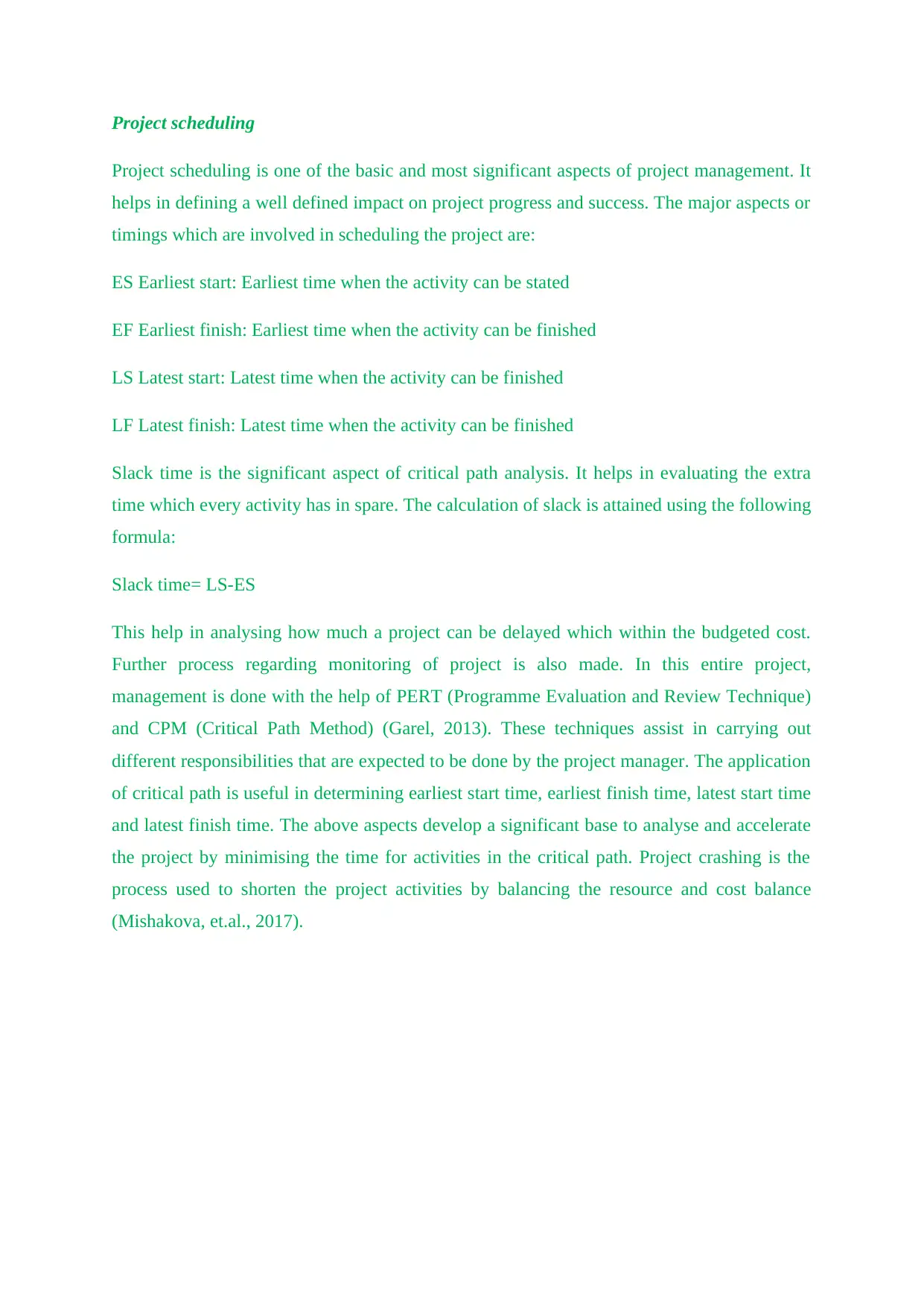
Project scheduling
Project scheduling is one of the basic and most significant aspects of project management. It
helps in defining a well defined impact on project progress and success. The major aspects or
timings which are involved in scheduling the project are:
ES Earliest start: Earliest time when the activity can be stated
EF Earliest finish: Earliest time when the activity can be finished
LS Latest start: Latest time when the activity can be finished
LF Latest finish: Latest time when the activity can be finished
Slack time is the significant aspect of critical path analysis. It helps in evaluating the extra
time which every activity has in spare. The calculation of slack is attained using the following
formula:
Slack time= LS-ES
This help in analysing how much a project can be delayed which within the budgeted cost.
Further process regarding monitoring of project is also made. In this entire project,
management is done with the help of PERT (Programme Evaluation and Review Technique)
and CPM (Critical Path Method) (Garel, 2013). These techniques assist in carrying out
different responsibilities that are expected to be done by the project manager. The application
of critical path is useful in determining earliest start time, earliest finish time, latest start time
and latest finish time. The above aspects develop a significant base to analyse and accelerate
the project by minimising the time for activities in the critical path. Project crashing is the
process used to shorten the project activities by balancing the resource and cost balance
(Mishakova, et.al., 2017).
Project scheduling is one of the basic and most significant aspects of project management. It
helps in defining a well defined impact on project progress and success. The major aspects or
timings which are involved in scheduling the project are:
ES Earliest start: Earliest time when the activity can be stated
EF Earliest finish: Earliest time when the activity can be finished
LS Latest start: Latest time when the activity can be finished
LF Latest finish: Latest time when the activity can be finished
Slack time is the significant aspect of critical path analysis. It helps in evaluating the extra
time which every activity has in spare. The calculation of slack is attained using the following
formula:
Slack time= LS-ES
This help in analysing how much a project can be delayed which within the budgeted cost.
Further process regarding monitoring of project is also made. In this entire project,
management is done with the help of PERT (Programme Evaluation and Review Technique)
and CPM (Critical Path Method) (Garel, 2013). These techniques assist in carrying out
different responsibilities that are expected to be done by the project manager. The application
of critical path is useful in determining earliest start time, earliest finish time, latest start time
and latest finish time. The above aspects develop a significant base to analyse and accelerate
the project by minimising the time for activities in the critical path. Project crashing is the
process used to shorten the project activities by balancing the resource and cost balance
(Mishakova, et.al., 2017).
⊘ This is a preview!⊘
Do you want full access?
Subscribe today to unlock all pages.

Trusted by 1+ million students worldwide
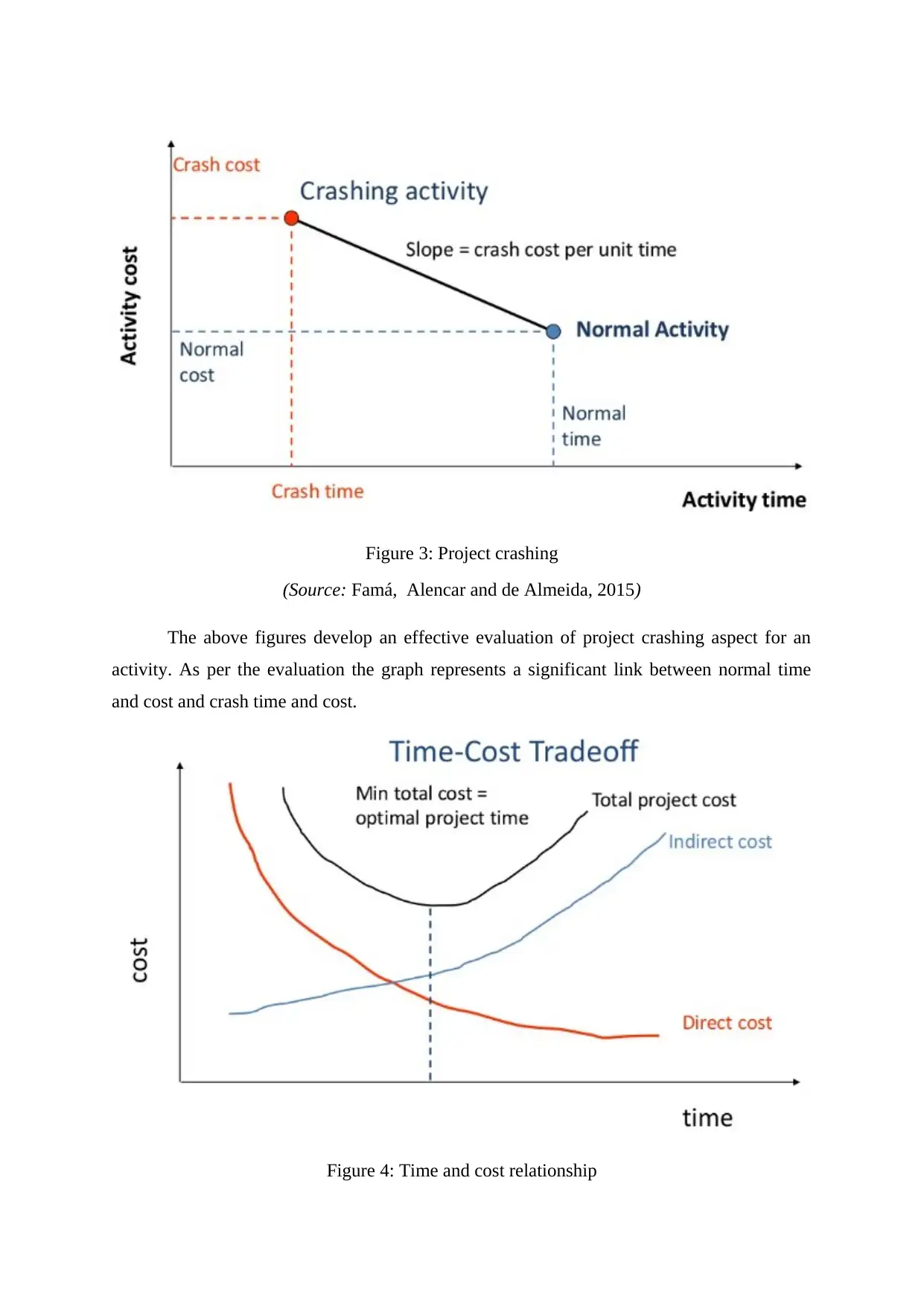
Figure 3: Project crashing
(Source: Famá, Alencar and de Almeida, 2015)
The above figures develop an effective evaluation of project crashing aspect for an
activity. As per the evaluation the graph represents a significant link between normal time
and cost and crash time and cost.
Figure 4: Time and cost relationship
(Source: Famá, Alencar and de Almeida, 2015)
The above figures develop an effective evaluation of project crashing aspect for an
activity. As per the evaluation the graph represents a significant link between normal time
and cost and crash time and cost.
Figure 4: Time and cost relationship
Paraphrase This Document
Need a fresh take? Get an instant paraphrase of this document with our AI Paraphraser
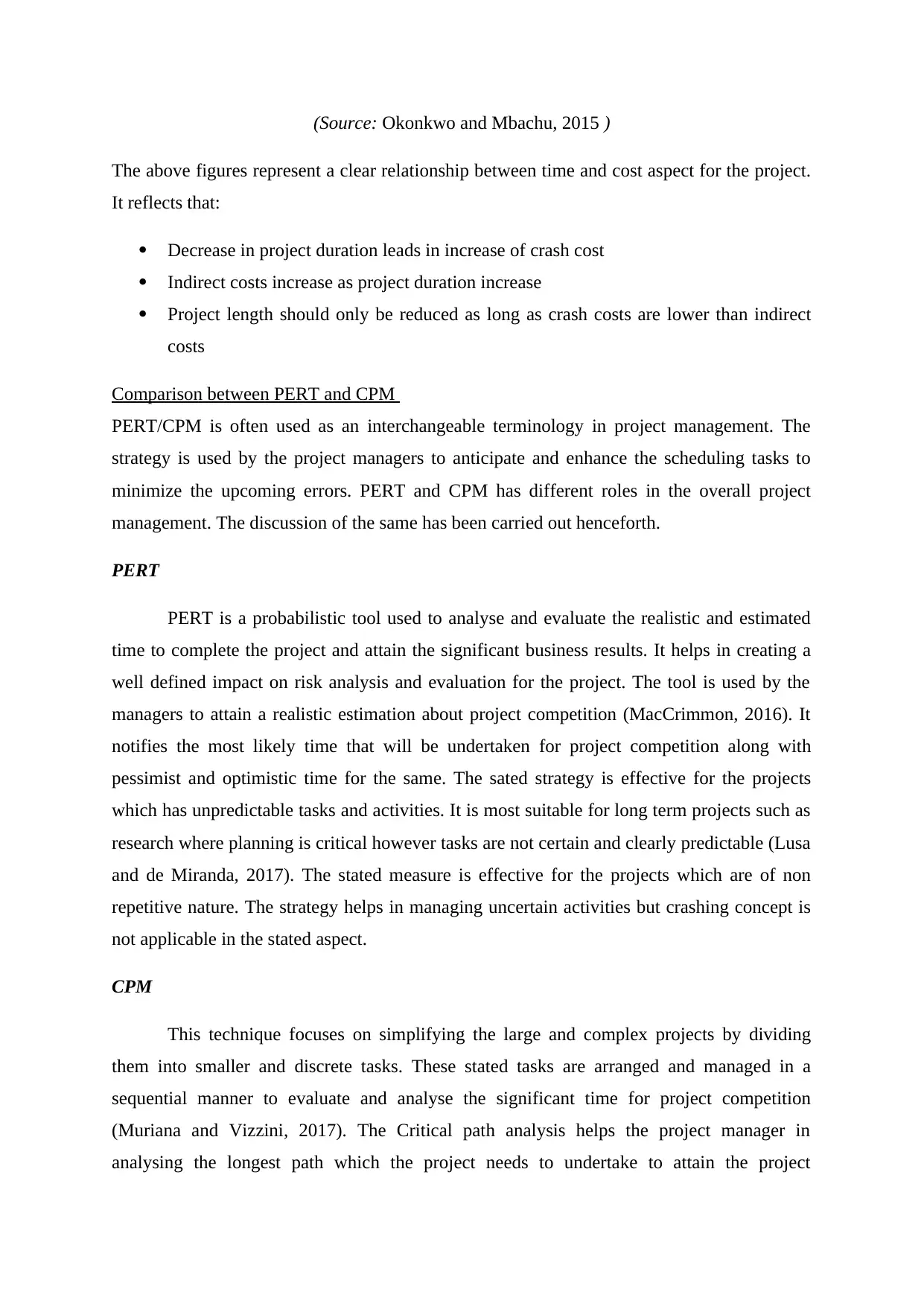
(Source: Okonkwo and Mbachu, 2015 )
The above figures represent a clear relationship between time and cost aspect for the project.
It reflects that:
Decrease in project duration leads in increase of crash cost
Indirect costs increase as project duration increase
Project length should only be reduced as long as crash costs are lower than indirect
costs
Comparison between PERT and CPM
PERT/CPM is often used as an interchangeable terminology in project management. The
strategy is used by the project managers to anticipate and enhance the scheduling tasks to
minimize the upcoming errors. PERT and CPM has different roles in the overall project
management. The discussion of the same has been carried out henceforth.
PERT
PERT is a probabilistic tool used to analyse and evaluate the realistic and estimated
time to complete the project and attain the significant business results. It helps in creating a
well defined impact on risk analysis and evaluation for the project. The tool is used by the
managers to attain a realistic estimation about project competition (MacCrimmon, 2016). It
notifies the most likely time that will be undertaken for project competition along with
pessimist and optimistic time for the same. The sated strategy is effective for the projects
which has unpredictable tasks and activities. It is most suitable for long term projects such as
research where planning is critical however tasks are not certain and clearly predictable (Lusa
and de Miranda, 2017). The stated measure is effective for the projects which are of non
repetitive nature. The strategy helps in managing uncertain activities but crashing concept is
not applicable in the stated aspect.
CPM
This technique focuses on simplifying the large and complex projects by dividing
them into smaller and discrete tasks. These stated tasks are arranged and managed in a
sequential manner to evaluate and analyse the significant time for project competition
(Muriana and Vizzini, 2017). The Critical path analysis helps the project manager in
analysing the longest path which the project needs to undertake to attain the project
The above figures represent a clear relationship between time and cost aspect for the project.
It reflects that:
Decrease in project duration leads in increase of crash cost
Indirect costs increase as project duration increase
Project length should only be reduced as long as crash costs are lower than indirect
costs
Comparison between PERT and CPM
PERT/CPM is often used as an interchangeable terminology in project management. The
strategy is used by the project managers to anticipate and enhance the scheduling tasks to
minimize the upcoming errors. PERT and CPM has different roles in the overall project
management. The discussion of the same has been carried out henceforth.
PERT
PERT is a probabilistic tool used to analyse and evaluate the realistic and estimated
time to complete the project and attain the significant business results. It helps in creating a
well defined impact on risk analysis and evaluation for the project. The tool is used by the
managers to attain a realistic estimation about project competition (MacCrimmon, 2016). It
notifies the most likely time that will be undertaken for project competition along with
pessimist and optimistic time for the same. The sated strategy is effective for the projects
which has unpredictable tasks and activities. It is most suitable for long term projects such as
research where planning is critical however tasks are not certain and clearly predictable (Lusa
and de Miranda, 2017). The stated measure is effective for the projects which are of non
repetitive nature. The strategy helps in managing uncertain activities but crashing concept is
not applicable in the stated aspect.
CPM
This technique focuses on simplifying the large and complex projects by dividing
them into smaller and discrete tasks. These stated tasks are arranged and managed in a
sequential manner to evaluate and analyse the significant time for project competition
(Muriana and Vizzini, 2017). The Critical path analysis helps the project manager in
analysing the longest path which the project needs to undertake to attain the project
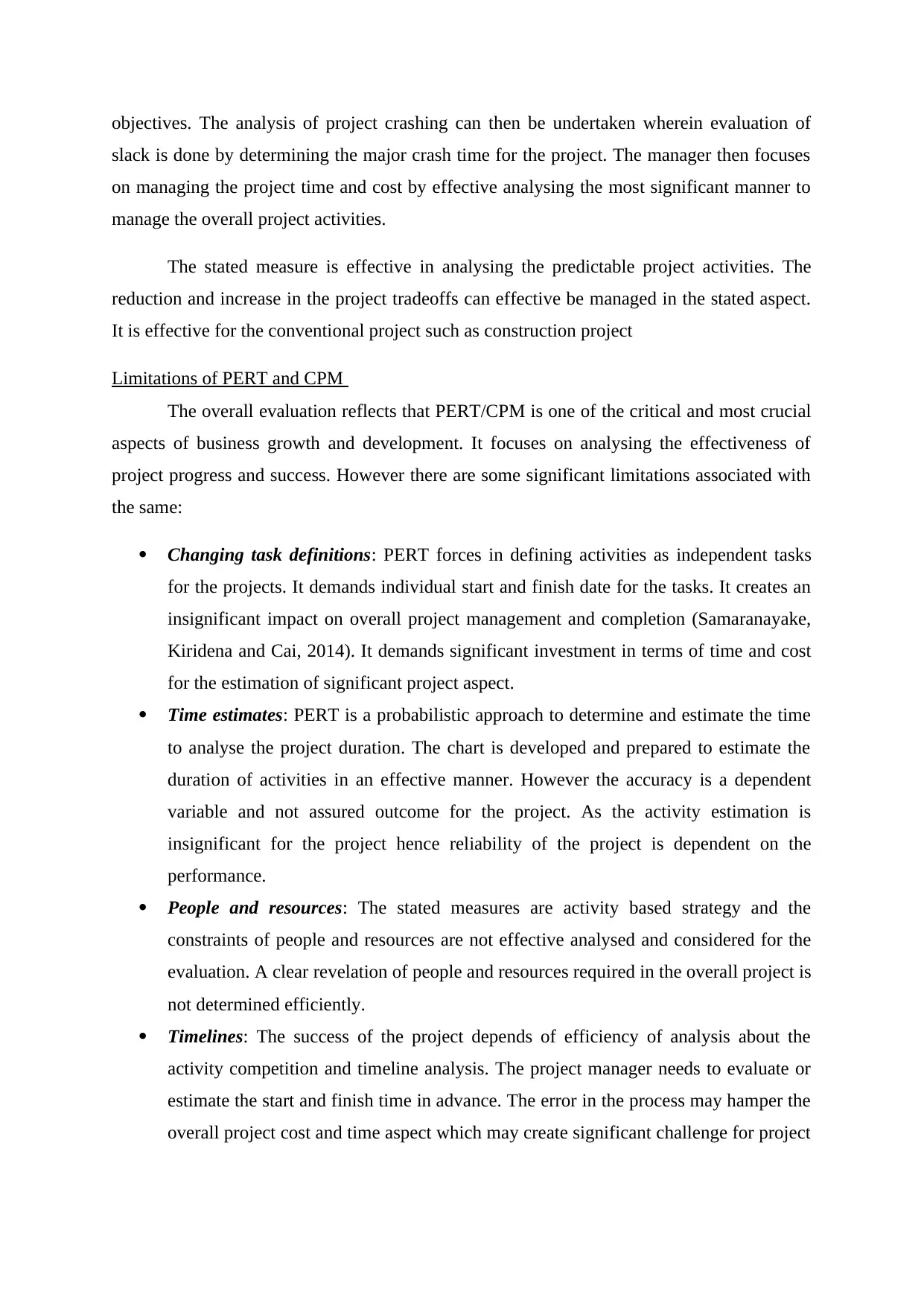
objectives. The analysis of project crashing can then be undertaken wherein evaluation of
slack is done by determining the major crash time for the project. The manager then focuses
on managing the project time and cost by effective analysing the most significant manner to
manage the overall project activities.
The stated measure is effective in analysing the predictable project activities. The
reduction and increase in the project tradeoffs can effective be managed in the stated aspect.
It is effective for the conventional project such as construction project
Limitations of PERT and CPM
The overall evaluation reflects that PERT/CPM is one of the critical and most crucial
aspects of business growth and development. It focuses on analysing the effectiveness of
project progress and success. However there are some significant limitations associated with
the same:
Changing task definitions: PERT forces in defining activities as independent tasks
for the projects. It demands individual start and finish date for the tasks. It creates an
insignificant impact on overall project management and completion (Samaranayake,
Kiridena and Cai, 2014). It demands significant investment in terms of time and cost
for the estimation of significant project aspect.
Time estimates: PERT is a probabilistic approach to determine and estimate the time
to analyse the project duration. The chart is developed and prepared to estimate the
duration of activities in an effective manner. However the accuracy is a dependent
variable and not assured outcome for the project. As the activity estimation is
insignificant for the project hence reliability of the project is dependent on the
performance.
People and resources: The stated measures are activity based strategy and the
constraints of people and resources are not effective analysed and considered for the
evaluation. A clear revelation of people and resources required in the overall project is
not determined efficiently.
Timelines: The success of the project depends of efficiency of analysis about the
activity competition and timeline analysis. The project manager needs to evaluate or
estimate the start and finish time in advance. The error in the process may hamper the
overall project cost and time aspect which may create significant challenge for project
slack is done by determining the major crash time for the project. The manager then focuses
on managing the project time and cost by effective analysing the most significant manner to
manage the overall project activities.
The stated measure is effective in analysing the predictable project activities. The
reduction and increase in the project tradeoffs can effective be managed in the stated aspect.
It is effective for the conventional project such as construction project
Limitations of PERT and CPM
The overall evaluation reflects that PERT/CPM is one of the critical and most crucial
aspects of business growth and development. It focuses on analysing the effectiveness of
project progress and success. However there are some significant limitations associated with
the same:
Changing task definitions: PERT forces in defining activities as independent tasks
for the projects. It demands individual start and finish date for the tasks. It creates an
insignificant impact on overall project management and completion (Samaranayake,
Kiridena and Cai, 2014). It demands significant investment in terms of time and cost
for the estimation of significant project aspect.
Time estimates: PERT is a probabilistic approach to determine and estimate the time
to analyse the project duration. The chart is developed and prepared to estimate the
duration of activities in an effective manner. However the accuracy is a dependent
variable and not assured outcome for the project. As the activity estimation is
insignificant for the project hence reliability of the project is dependent on the
performance.
People and resources: The stated measures are activity based strategy and the
constraints of people and resources are not effective analysed and considered for the
evaluation. A clear revelation of people and resources required in the overall project is
not determined efficiently.
Timelines: The success of the project depends of efficiency of analysis about the
activity competition and timeline analysis. The project manager needs to evaluate or
estimate the start and finish time in advance. The error in the process may hamper the
overall project cost and time aspect which may create significant challenge for project
⊘ This is a preview!⊘
Do you want full access?
Subscribe today to unlock all pages.

Trusted by 1+ million students worldwide
1 out of 16
Related Documents
Your All-in-One AI-Powered Toolkit for Academic Success.
+13062052269
info@desklib.com
Available 24*7 on WhatsApp / Email
![[object Object]](/_next/static/media/star-bottom.7253800d.svg)
Unlock your academic potential
Copyright © 2020–2025 A2Z Services. All Rights Reserved. Developed and managed by ZUCOL.





